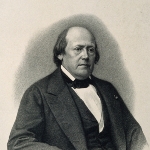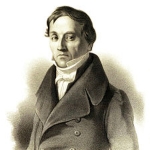Background
Lereboullet was born on September 19, 1804, at Épinal, France, the son of an employee in the administration of indirect taxation at Épinal.


Fahnenbergplatz, 79085 Freiburg im Breisgau, Germany
After obtaining baccalaureates in letters and sciences at the Collège de Colmar, Lereboullet spent a year at the University of Freiburg. There he studied German and was introduced to German science, a subject that he later analyzed, over a period of nearly thirty years, for the Gazette médicale de Paris.

11 Rue du Maréchal Juin, 67000 Strasbourg, France
Returning to France, Lereboullet studied medicine at Strasbourg, then in 1832 obtained permission to study the cholera epidemic at Paris. The data that he thus gathered was incorporated in the thesis with which he obtained the M.D. in the same year.
Fahnenbergplatz, 79085 Freiburg im Breisgau, Germany
After obtaining baccalaureates in letters and sciences at the Collège de Colmar, Lereboullet spent a year at the University of Freiburg. There he studied German and was introduced to German science, a subject that he later analyzed, over a period of nearly thirty years, for the Gazette médicale de Paris.
11 Rue du Maréchal Juin, 67000 Strasbourg, France
Returning to France, Lereboullet studied medicine at Strasbourg, then in 1832 obtained permission to study the cholera epidemic at Paris. The data that he thus gathered was incorporated in the thesis with which he obtained the M.D. in the same year.
Lereboullet was born on September 19, 1804, at Épinal, France, the son of an employee in the administration of indirect taxation at Épinal.
After obtaining baccalaureates in letters and sciences at the Collège de Colmar, Lereboullet spent a year at the University of Freiburg. There he studied German and was introduced to German science, a subject that he later analyzed, over a period of nearly thirty years, for the Gazette médicale de Paris. Returning to France, he studied medicine at Strasbourg, then in 1832 obtained permission to study the cholera epidemic at Paris. The data that he thus gathered was incorporated in the thesis with which he obtained the M.D. in the same year.
Lereboullet entered the Faculty of Sciences at Strasbourg as préparateur for G. L. Duvernoy, a friend and former collaborator of Cuvier. When in 1838 Duvernoy was appointed to Cuvier’s chair at the College de France, Lereboullet (who had in 1837 received the licentiate and in 1838 the doctorate in natural science) succeeded him at Strasbourg in the chair of zoology and animal physiology.
Lereboullet had begun his zoological work by studying the comparative anatomy of vertebrates. His doctoral thesis dealt with the comparative anatomy of the respiratory system, while in another early work, which was awarded a prize by the Academy of Sciences, he examined the comparative anatomy of the genital organs in vertebrates. It was perhaps indicative of the German influence on his work that Lereboullet then took up the study, novel to France, of comparative histology. His memoir on the cellular structure of the liver, for which be was awarded the Portal Prize by the Academy of Medicine in 1851, described how cells are altered in the common pathological condition known as foie gras.
In 1849 Lereboullet began his celebrated research in comparative embryology. Having learned to fertilize fish eggs artificially, he was able to examine microscopically the earliest phases of development. In 1853 the Academy of Sciences proposed for competition the problem of comparing the development of a vertebrate with a mollusk or an articulate and Lereboullet chose as research subjects the pike, the perch, and the crayfish. Although he was paid for his work the Academy did not find it adequate to the problem, which was reset in 1856. This time Lereboullet studied the trout, the lizard, and the pond snail, and concluded his memoir with generalizations that satisfied the Academy, which awarded him the prize in 1857.
Lereboullet divided monsters into two groups (single and double) and seven classes, which he attributed to modifications in the blastodermic thickening and the embryonic bond. He recognized that the thickened edge of the blastoderm - the embryonic ring - gives rise to all embryonic structures and suggested that double monsters develop from two separate points in the blastodermic thickening. For these experiments the Academy gave Lereboullet the Alhumbert Prize, which he shared with Camille Dareste, although they had arrived at opposite theoretical conclusions.
In describing the earliest phases of animal development Lereboullet divided the elements constituting the fertilized egg into plastic elements (deriving from the germinative vesicle) that would eventually produce the cells of “animal life” and nutritive elements (deriving from the vitellus) that would produce the organs of “vegetative life.” His work was precisely observed and factual. As a member of the école de cuvier, he avoided theory and rejected the hypotheses of spontaneous generation, unity of type, recapitulation, multiple origin of the human species, and transformism.
He was active in several scientific societies, directed the Museum of Natural History of Strasbourg, and acted as dean of the Faculty of Sciences from 1861 until his death.
(French Edition)
1833(French Edition)
1851In his memoir Lereboullet had analyzed all phases of development, beginning with the unfertilized egg. He concluded that the unfertilized egg in all of his subjects appeared to be similar in the first three of Cuvier’s four embranchments, but that soon after fertilization the paths of development separated, each embranchment manifesting its own proper characteristics. Finding himself in accord with von Baer and Henri-Milne Edwards, Lereboullet argued against the doctrine of unity of type and against E. R. A. Serres’ recapitulation theory.
While studying the pike, Lereboullet noticed the frequent occurrence of monstrosities. Geoffroy Saint-Hilaire had previously claimed that monsters could be produced at will by the use of external agents, and the Academy set the problem of whether determined monstrosities could be experimentally produced by known physical agents for the subject of a competition in 1860. Lereboullet had begun to make teratological experiments in 1852. He subjected nearly 300,000 pike eggs to such disturbing agents as heat, cold, running water, and brushing, and carefully tabulated his results, noting that neither the fact nor the agent of perturbation had an effect on the number or type of abnormality that occurred. He concluded that abnormalities were most probably inherent in the structure of the germ, rather than caused by outside agents.
Lereboullet was a modest and religious man.
Lereboullet was married; two of his sons later became doctors.


